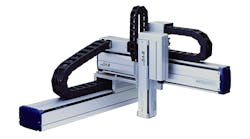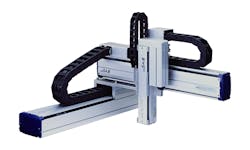Nigel Smith, Founder and CEO, TM Robotics
Machine Design had a chance to talk with Nigel Smith, founder and CEO of TM Robotics, about the current climate of the robotics industry, and the “keep-it-simple” KISS steps taken toward robot integration.
What is your background? How did you get your start?
I have been deeply involved with robotic sales and development for 30 years, since beginning my career at Toshiba Machine in 1986. There, I was responsible for the sales, marketing, and support of the company’s PLC and industrial robot product range throughout all of Europe, Middle East, and Africa (EMEA).
When I left Toshiba Machine in 2000, I founded TM Robotics to focus entirely on Toshiba Machine robot sales in Europe, the Middle East, Africa, India, Russia, Canada, and North and South America. My close relationship with Toshiba Machine has enabled me to influence product updates and the creation of new robots throughout the years, from end-of-arm tooling to robot mechanical structures and new controllers. I have also advised Toshiba Machine on new markets to enter.
What types of robots are currently the most in demand, and why?
For fully automated system requirements, we are seeing a growing demand for medium to large Cartesian robots. As factories try to cram more and more automation into limited areas, it is often difficult to reserve enough space in a work cell for a 6-axis robot, for instance, which requires a clear operating area of about two meters in diameter to accommodate its 1000-mm reach. And many applications simply don’t need six axes of motion, or the high speed and payload capabilities of a SCARA (Selective Compliance Assembly Robot Arm) robot, so Cartesian robots are often ideal solutions.
Of course, there’s lots of news about the growth of collaborative robots (cobots), which let small manufacturers—who would never have considered robots before—embrace automation to bolster their manual processes. But cobots can’t effectively address traditional manufacturing processes that demand high speeds and medium to high payloads. The good news is, as those companies grow and expand their operations, that introduction to automation means they will be better prepared to move to fully automated systems that support bigger, faster, and more accurate processes.
What are some of the advantages of a robot that uses a Cartesian gantry system compared to a jointed or arm-like design?
Each type of robot arm offers advantages for specific applications. In many cases, though, the first consideration is the size of the robot’s work envelope. SCARA and 6-axis robots require a large circular (as much as two meter diameter) work envelope to allow for movement in any horizontal direction. For applications requiring that range of motion—plus the Z axis and potentially the additional theta rotation of the SCARA robot—that work envelope makes sense, and the additional advantages of these robots in terms of payload, accuracy, and speed make the space requirement worthwhile.
But what we are finding is that many of today’s automation requirements can be effectively addressed with a 3- or 4-axis Cartesian system. These have a much smaller footprint than a SCARA or 6-axis robot, because it is essentially a back-and-forth (and possibly up-and-down) motion, making the work envelope long and narrow rather than circular.
This offers the advantages of a reduced footprint, as well as quicker and easier installation, and a shorter learning curve for operators and local maintenance technicians because of the reduced number of axes. Those features can be key factors in older assembly lines or manufacturing sites where modifications and retrofits are being installed, versus a new line being built from scratch.
TM Robotics' BA-III Cartesian robot.
Compared to the heavier-duty or more complex SCARA or 6-axis robots, Cartesian systems can be cost-effective and flexible solutions for facilities with tight budgets. That’s because Cartesians and SCARAs work on the horizontal plane, whereas the 6-axis robots are “vertically articulated” robots.
What are key considerations in comparing dedicated automation to off-the-shelf components?
We tend to think in terms of fixed versus flexible automation. Fixed, or dedicated, automation is an automation cell that is designed to exactly meet the requirements of specific tasks. Dedicated automation may be required in some instances, such as custom designs for tricky parts or applications, but it comes at a cost, of course, both in physical expenses as well as engineering time.
In contrast, flexible automation allows the system to be adapted and updated for reuse elsewhere or for different processes. The robot itself is essentially a component, which is defined by its operating movement, speed, payload, reach, etc., and then we create a system that is ideally suited for the application using a full range of flexible components. So the system is ideal for today’s needs. But if you need to change the application or apply the robot to new processes later on, you can easily add an extra axis and driver, for instance, and update your system for your current needs.
What are the advantages of offering a full line of robotic solutions?
Finding a provider that offers a complete line of automation options that include Cartesian, SCARA, and 6-axis articulated robots ensures users get the right robot for each application. Installing the wrong system—whether it is too large and complicated or too simplistic—can have a huge impact on customers’ return on investment.
In addition, having multiple types of robot arms from the same company can maintain commonality of programming languages, spare parts, service, and support. Customers with a variety of assembly applications in one facility can take advantage of the benefits of each machine, selecting the one that best suits each application.
Is it better to have plug-and-play or custom features in a robotics solution?
The advantage of plug-and-play features is that you get a custom solution that is ideally built for your needs, without the extra cost, time, and effort required to create the system yourself. Plug-and-play is critical to getting systems from the design table to the factory floor quickly and efficiently. Customers get a completely integrated system that they can install and begin programming right out of the box.
Systems that aren’t plug-and-play simply represent more complex, costly ways to customize. The customer has to specify a robot and multiple actuators, and then needs to research, buy, and integrate individual motors, cabling, brackets, etc. All of that typically adds weeks to the timetable before they can even begin programming the robot.
What are the key factors to look for in a plug-and-play system?
A plug-and-play system should take the engineering complexity, stress, and calibration requirements out of a robotic installation. With a basic set of user specifications, it should allow the vendor to quickly and cost-effectively put together a system that will meet the customer’s needs and perform as expected or better, with a team of engineers willing to back that up. And while plug-and-play gets a customer up and running as quickly as possible, it also should provide ways for the customer to dig into the program and the system to get even greater performance. If customers demand deep access to a system, the manufacturer should provide this access.
What are the cost, time, and other benefits to using robots?
Robotics has evolved to the point where the cost and time to implement them has become a non-issue for many applications. They can be set up and programmed in a matter of days, so they can begin offering advantages almost immediately. Costs have come down dramatically, and programming and operation have become much simpler.
Robots are reliable and energy-efficient, and Ethernet and Wi-Fi connectivity make them easy to maintain and troubleshoot. For manufacturers, the ability to precisely pick, assemble, and package products efficiently and economically is improving their ability to compete in global markets. With improved product quality and consistency from highly accurate automation, companies are better able to meet demanding consumer expectations. And with so many manufacturers having difficulty filling manufacturing jobs, robots allow them to increase productivity and let human workers move into safer, more fulfilling and more interesting roles.



